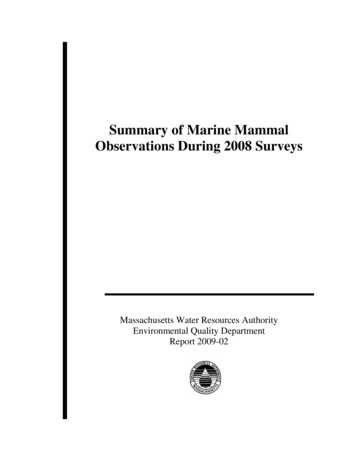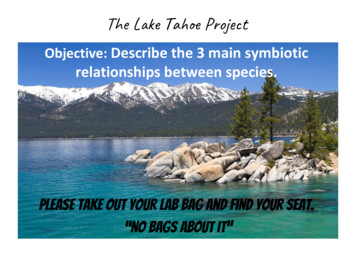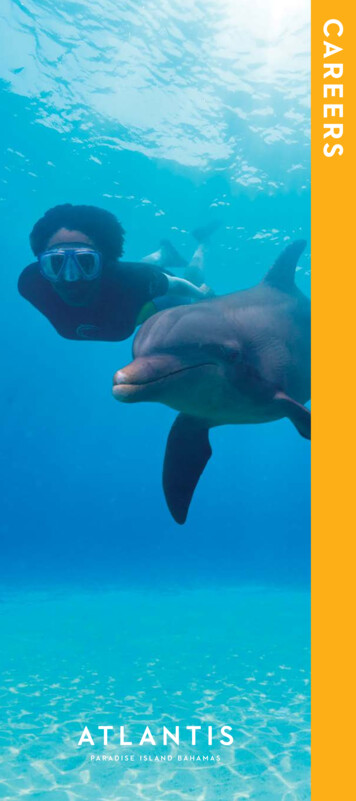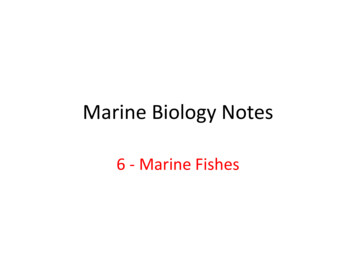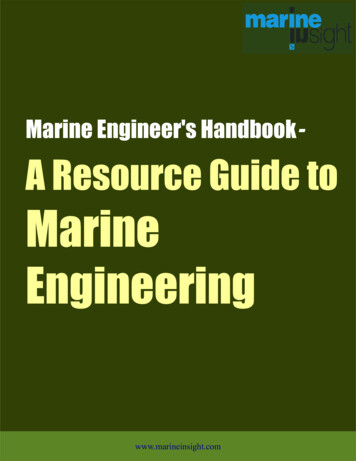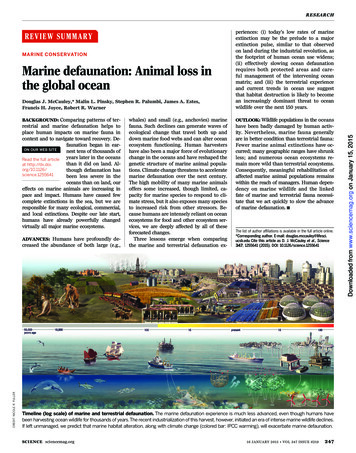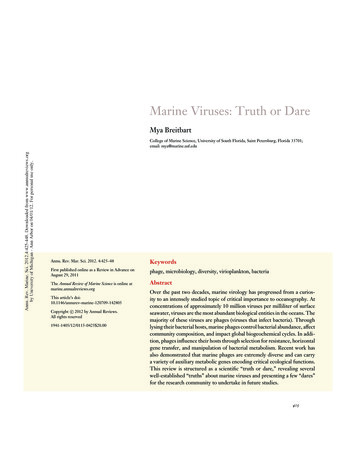
Transcription
Summary of Marine MammalObservations During 2005 surveysMassachusetts Water Resources AuthorityEnvironmental Quality DepartmentReport ENQUAD 2006-04
CitationShort LM, Michelin D. 2006. Summary of marine mammal observations during 2005 surveys.Boston: Massachusetts Water Resources Authority. Report ENQUAD 2006-04. 17 p.
SUMMARY OF MARINE MAMMAL OBSERVATIONSDURING 2005 SURVEYSforMWRA Harbor and Outfall Monitoring Projectsubmitted toMASSACHUSETTS WATER RESOURCES AUTHORITYEnvironmental Quality Department100 First AvenueCharlestown Navy YardBoston, MA 02129(617) 242-6000prepared byLynda M. ShortDerek MichelinBattellesubmitted byBattelle397 Washington StreetDuxbury, MA 02332(781) 934-0571March 7, 2006Report No: 2006-04
Marine Mammal Observation Report – 2005March 7, 2006AcknowledgementsMarine mammal observers were individually contracted to assist Battelle in collecting the datacontained in this report. The dedication and professionalism of David Silvia is appreciated.Special thanks are extended to Mason Weinrich, Director of the Whale Center of New Englandand Owen Nichols from the Center for Coastal Studies for their review and input of generalwhale sighting information in this report.Thanks and appreciation are also extended to the captains, crews, and scientific personnel of theR/V Aquamonitor, R/V Tioga, R/V Merganser, F/V Shanna Rose, F/V Key Largo, F/V FirstLight, and F/V Morning Light, who assisted in the surveys.ii
Marine Mammal Observation Report – 2005March 7, 2006TABLE OF CONTENTS1.02.03.04.05.06.07.0INTRODUCTION . 1BACKGROUND . 1METHODS . 3RESULTS . 7DISCUSSION . 11SUMMARY OF WHALE SIGHTINGS 1998 THROUGH 2005 . 12REFERENCES. 15LIST OF TABLESTABLE 1. MARINE MAMMAL OBSERVER SIGHTINGS DURING MWRA 2005 WATER QUALITY MONITORING PROGRAM.7TABLE 2. SIGHTINGS BY AREA, SPECIES, AND YEAR .13LIST OF FIGURESFIGURE 1. LOCATION OF NEARFIELD STATIONS .4FIGURE 2. LOCATION OF FARFIELD STATIONS .5FIGURE 3. LOCATION OF FECAL COLIFORM/ ADVERSE CONDITIONAL STATIONS .6FIGURE 4. APPROXIMATE LOCATIONS OF WHALE SIGHTINGS DURING 2005 MWRA WATER QUALITY SURVEYS .10FIGURE 5. DISTRIBUTION OF SIGHTINGS BY SPECIES AND AREA, 1998-2005 .14FIGURE 6. TOTAL SIGHTINGS OF WHALES BY AREA, 1998-2005.14FIGURE 7. DISTRIBUTION OF SIGHTINGS WITHIN THE FOUR IDENTIFIED AND UNIDENTIFIED SPECIES CATEGORIES .15iii
Marine Mammal Observation Report – 2005March 7, 20061.0 IntroductionAt least five endangered species of whales are known to visit or inhabit the Massachusetts and Cape CodBay area (EPA 1993): the right whale, humpback whale, finback whale, sei whale (rarely observed) andblue whale (rarely observed). Several non-endangered Marine Mammal species are also found: minkewhales, harbor porpoise, several dolphin species, gray seals, and harbor seals.Since 1995, Massachusetts Water Resources Authority (MWRA) has included marine mammal observerson monitoring surveys. The MWRA surveys are being conducted as part of the long-term Harbor andOutfall Monitoring Project designed to verify compliance with the discharge permit and to assess thepotential environmental impact of treated sewage effluent discharge into Massachusetts Bay. Theseobservers were included in response to a National Marine Fisheries Service (NMFS) request that MWRAprovide observational data and set a positive example by using observers to minimize the chances ofcollision with a right whale. In addition to looking for right whales, observers conducted observations forother marine mammals. On surveys where observers were not present, the chief scientist and field crewdocumented any incidental sightings of marine mammals.Marine mammal observers were present on 15 water quality surveys during 2005 (12 Nearfield and threeFarfield surveys). Throughout the year, observers were present on all of the Nearfield water columnsurveys (n 12) to document the sightings of right whales in the Nearfield. Observers were present onthree (WF051, WF052, and WF054) of the six Farfield water column surveys.2.0 BackgroundA brief description of when marine mammals are expected to be found in Massachusetts and Cape CodBays is presented and discussed below.The right whale (Eubalaena glacialis) is critically endangered. Based on historical sightings made, rightwhales can be expected to visit Massachusetts and Cape Cod Bays throughout the year (Brown et al.2002), with peak abundance in February, March and early April (Hamilton and Mayo 1990). Over thepast four decades, 72% of the catalogued population of right whales has visited Cape Cod Bay andMassachusetts Bay (Brown et al. 2002). For the period of 1978 through 1986, using photographedsightings of right whales collected from whale watch boats and research cruises, the total number ofindividually identified right whales in Cape Cod Bay ranged from a single animal in 1978 to 47individuals in 1986 (Hamilton and Mayo 1990). Within the last five years, the use of the eastern portionof Stellwagen Bank/Wildcat Knoll by right whales has been noted during extended surveys by the Centerfor Coastal Studies (Brown et al. 2002).The humpback whale (Megaptera novaeangliae) is an endangered species of whale known to feed withinthe Gulf of Maine in the spring, summer and fall (Waring et al. 1999). Historic records indicate thathumpbacks have been documented on Stellwagen Bank from mid-April through November, with a peakabundance in May and June (CeTap 1982; NMFS 1991). However, distribution appears to correlate withprey densities (Waring et al. 1999). In 1992-1993, humpbacks were most abundant in offshore waters ofCultivator Shoals and the Northeast Peak of Georges Bank and less abundant in the nearshore areas(Langton et al. 1994). In 1996-1997, an increase in humpback whale sightings correlated with anabundance of sandlance (Ammodytes dubius) in the Stellwagen Bank area (Waring et al. 1999).The finback whale (Balaenoptera physalus) is considered to be an endangered species and is the mostabundant and frequently sighted of the endangered whales that visit Massachusetts and Cape Cod Bays1
Marine Mammal Observation Report – 2005March 7, 2006(EPA 1993). Finbacks are sighted year round in the Stellwagen Bank area with a peak abundanceoccurring between the spring and fall (Pett and McKay 1990).The sei whale (Balaenoptera borealis) and blue whale (Balaenoptera musculus) are endangered speciesrarely sighted in Massachusetts and Cape Cod Bays (EPA 1993). Both blue and sei whales typicallyremain in deeper water (more than 100 meters) and further offshore (CeTap 1982). However, sightings ofthese species in coastal areas may correspond to changes in prey distribution (Payne et al. 1990, Wenzelet al. 1988).The minke whale (Balaenoptera acutorostrata) is a non-endangered species typically seen in theStellwagen Bank area during the spring, summer and fall (CeTap 1982; Pett and McKay 1990). Duringthe winter, minke whale sightings in New England appear to decline dramatically (Waring et al. 1999).The Atlantic white-sided dolphin (Lagenorhynchus acutus) is a species of dolphin found from centralwest Greenland to North Carolina (Waring et al. 1999). The Gulf of Maine stock of Atlantic white-sideddolphins is classified as strategic by the National Marine Fisheries Service (Waring et al. 1999).Sightings of these dolphins in the Stellwagen Bank and Cape Cod Bay areas are common in the springand, to a lesser extent, the fall (Pett and McKay 1990).The Atlantic pilot whale or long-finned pilot whale (Globicephala melaena) is the largest species ofdolphin found in cool temperate waters off Labrador, Newfoundland, and in the St. Lawrence River withsporadic sightings as far south as Maryland and Virginia (Bulloch 1993). Pilot whales form schools of afew to many hundreds of individuals and are mainly found relatively close to shore. Pilot whaledistribution and abundance appear to be linked to the topography of the sea floor and the abundance oftheir primary food source, squid (Harrison and Bryden 1989).The gray seal (Halichoerus grypus) is a non-endangered species of pinniped found from Maine to LongIsland Sound (Rough 1995). A small, year round breeding population is known to occur on outer CapeCod and Nantucket Island (Waring et al. 1999). The majority of gray seal sightings in Cape Cod Bayand the Stellwagen Bank area occur during the winter and spring, although periodic sightings have beenrecorded in the summer (Center for Coastal studies unpublished data).Harbor porpoises (Phocoena phocoena) of the Gulf of Maine/Bay of Fundy stock are classified asstrategic by the National Marine Fisheries Service (Waring et al. 1999). Historic data indicate that harborporpoises can be found in the Stellwagen Bank area and Cape Cod Bay from December through June(Pett and McKay 1990).The harbor seal (Phoca vitulina) is a non-endangered species of pinniped commonly found in the nearshore waters around New England (Katona et al. 1993). Harbor seals are most frequently seen in theStellwagen Bank and Cape Cod Bay areas in the winter and early spring with sightings beginning in lateSeptember (Pett and McKay 1990).2
Marine Mammal Observation Report – 2005March 7, 20063.0 MethodsMarine mammal observations were performed during all daylight hours while transiting during Nearfieldwater column surveys (Figure 1), and while the vessel was on-station for sampling operations. Additionally,marine mammal observers were present during three winter/spring Farfield surveys (Figure 2) during the2005 survey year. During vessel transits, the observer continuously scanned the sea surface from directlyahead to 90 degrees abeam on either side of the vessel. Initial sightings were made by eye withconfirmation and identification aided by binoculars. While on-station, the observer scanned 360 degreesaround the vessel. The observer was typically positioned at the highest and most secure vantage point of thesurvey vessel. Weather conditions, safety of the observer, and limiting interference with the operation of thevessel and sampling team were all factors that influenced the position of the observer on board the vessel.Two survey vessels were used as observation platforms during the course of the year. The observer’s eyeheight above the sea surface was approximately 5 meters on the R/V Tioga and 2.5 meters aboard the R/VAquamonitor. Observations were conducted 40 minutes out of every hour and were suspended whenvisibility was reduced to zero or when darkness occurred.Several other vessels were also used to conduct surveys where marine mammal observers were not present,the scientific crew on board the R/V Merganser, F/V Shanna Rose, F/V Key Largo, F/V Morning Light, andF/V First Light observed marine mammals while on surveys. Many of these vessels were used to conductMWRA Inner Harbor surveys. Unlike previous years, data from the Inner Harbor surveys are included inthis report. Furthermore, the R/V Merganser conducted all Fecal Coliform Surveys in the Nearfield andFarfield areas (Figure 3).Vessel track, station sequence, and number of stations varied among cruises, due to the constraints ofweather, special survey requirements, or both.3
Marine Mammal Observation Report – 2005March 7, 2006Figure 1. Location of Nearfield Stations4
Marine Mammal Observation Report – 2005March 7, 2006Figure 2. Location of Farfield Stations5
Marine Mammal Observation Report – 2005March 7, 2006Figure 3. Location of Fecal Coliform/ Adverse Conditional Stations6
Marine Mammal Observation Report – 2005March 7, 20064.0 ResultsObservation of marine mammals on surveys designed and operated for the collection of water quality dataplaces limitations and constraints on the method of observation and on the conclusions that may be drawnfrom the data. Standard line transect methodology is not possible on such surveys, and two different vessels(which vary the characteristics of the survey platform) were used during the year. Based on these factors,the ability to extrapolate from observation data to abundance estimates is severely limited and is notadvisable. The utility of this data set is thus limited to documentation of the time, location and particularsfor each individual occurrence of a sighting and provides useful qualitative information concerning seasonalpatterns and relative abundance within the same study area.During the 2005 monitoring year, 31-33 individual whales, 16-21 harbor porpoise, one unidentifiedporpoise, and a small pod of Atlantic white-sided dolphins were directly observed by the marine mammalobservers, Battelle survey team members, and MWRA survey team members. Included in these sightingswere five humpback whales, one finback whale, seventeen minke whales, and eight to ten instances ofunidentifiable whales (possibly two minke whales). Whale sightings in 2005 were concentrated mainly inMassachusetts Bay (Figures 1, 2, and 3) and of the whales sighted, four whales were sighted in the vicinityof the Nearfield area. The total number of whales (32) sighted during 2005 was greater than during severalprevious years (2004, 11 sightings; 2003, 15 sightings; 2002, 16 to 19 sightings; and 2001, 20 sightings),and less than sightings during the years of 2000, (53 sightings) and 1999, (59 sightings) (Short et al. 2005).Similar to 2003, right whales were not observed during 2005 water column surveys. It should also be notedthat whales were observed on other types of surveys in addition to the water column surveys. Both theBenthic Farfield and Nearfield (BN/BF) survey and the Stellwagen Bank survey, which was conducted forthe Stellwagen Bank National Marine Sanctionary (SW), are included in the observations in Table 1, as wellas the Rapid Response Alexandrium Surveys conducted in both Massachusetts and Cape Cod Bays and theBoston Harbor surveys conducted by MWRA. In addition to the whales, 76 harbor seals were also sightedduring the year. All sightings recorded by a dedicated marine mammal observer or other survey personnelare summarized in Table 1. Whale sighting distribution is presented in Figure 4. The second column inTable 1 provides the figure location and corresponds to a circle on Figure 4.Table 1. Marine Mammal Observer Sightings During MWRA 2005 Water Quality Monitoring ProgramSurvey IDPC051F/V Shanna RosePC052F/V Shanna RoseWF051/WN051R/V TiogaFigureLocation1Date\TimeNumberLocationNo sightings02/14/05No sightings02/01/05 0735102/01/05 1525102/07/05 1535Sighting Comments201/26/0502/02/05WF052/WN052R/V r sealUnidentifiedOdontocete42 18.75’N/070 55.13’WHauled out on rocks SE side ofGeorge’s Island.Yes41 54.22’N/070 14.58’WYesNo sightingsAtlantic white-sideddolphins42 04.23’N/070 31.26’WYesYesNo sightingsYes02/26/05 07501Harbor seal02/26/05 10361Harbor sealHauled out on Toddy Rocks,North shore of Hull42 19.18’N/070 53.58’WObserved between station F07 &F12.42 12.84’N/070 30.27’W02/27/05 17151Harbor seal42 19.80’N/070 56.11’WHauled out on rock.Yes02/27/05 17254Harbor seals42 18.67’N/070 65.65’WHauled out on rocks.Yes7YesYes
Marine Mammal Observation Report – 2005March 7, 2006Table 1. Marine Mammal Observer Sightings During MWRA 2005 Water Quality Monitoring ProgramSurvey IDFigureLocation1BHWQMR/V MerganserPC053R/V MerganserWN053R/V AquamonitorDate\TimeNumberMammal03/16/05 09101Harbor porpoiseInner Harbor-off Coast GuardStationNo03/16/05 09201Harbor porpoiseInner Harbor-off Logan AirportNo03/21/051CSORWMR/V MerganserWN054/WF054R/V AquamonitorPA051 (PC054)F/V First LightBHWQMR/V Merganser103/29/05 10261Harbor seal42 20.56’N/071 08.66’W04/04/05 10301Harbor porpoise42 56.62’N/070 14.32’W04/04/05 133004/05/0504/06/05 083004/06/05 085504/06/05 091004/06/05 0910221111Harbor sealsNo sightingsHarbor PorpoiseHarbor sealHarbor sealHarbor seal04/06/05 14205Harbor seals04/06/05 162011Harbor seals04/06/05 16207Harbor sealsNoYesYesHauled out on rocks at “BugLight”.42 20.49’N/070 00.34’W42 20.35’N/070 56.50’W42 20.63’N/070 56.23’W42 20.63’N/070 56.23’WObserved while at station F30.Observed while at station F23.Sighting 200 from vessel.Sighting 270 from vessel.Hauled out on Toddy Rocks,42 18.90’N/070 54.78’WNorth end of Hull.Hauled out on rocks, South end ofGeorge’s Island.42 19.22’N/070 55.12’WHauled on rocks, North end of42 19.22’N/070 55.12’WHull.YesYesYesYesYesYesYesYesYesNo sightingsYes04/13/05No sightingsNo04/22/05 0906204/22/05 0915105/13/0505/05/05 0903106/13/05306/09/05 1329Harbor porpoises 42 20.59’N/071 00.48’WJuvenile HumpbackInner Harbor-Reserved Channel,whaleCastle IslandNo sightings1NoYesHarbor seal42 18.00’N/070 48.50’WNoNo sightingsUnidentified Baleenwhale42 00.75’N/070 15.55’WNoNorth of Station F33No06/13/05No sightingsNo06/14/05No sightingsYes06/17/05No sightingsYes406/28/05 1301106/28/05 145915PC057R/V MerganserAF058R/V AquamonitorWN059R/V Aquamonitor42 59.31’N/070 38.85’WObserverPresent04/07/0506/18/05AF057R/V AquamonitorSighting CommentsNo sightingsUnidentified Baleenwhale (possibly aminke)42 21.30’N/070 47.00’W03/17/05 12002WN056R/V AquamonitorPC055R/V MerganserPC056R/V MerganserAF055R/V AquamonitorWF057/WN057R/V AquamonitorLocation07/05/0507/06/05 112807/18/05No sightingsUnidentified Baleenwhale42 28.79’N/070 16.36’WUnidentified Baleenwhale42 19.73’N/070 36.57’WNo sightings1NoNoNoNoObserved while at stationF02.SealNo sightingsNoYes8
Marine Mammal Observation Report – 2005March 7, 2006Table 1. Marine Mammal Observer Sightings During MWRA 2005 Water Quality Monitoring ProgramSurvey IDBF051/BN051R/V AquamonitorPC058R/V MerganserWF05B/WN05B/SW051R/V cationSighting Comments08/04/05 095015Minke WhalesSouth of FF06Observed swimming in groups of2-3.08/09/05No sightings9No08/16/05 15393-508/17/05 093008/19/05 105311Unidentified BaleenwhalesStation F28Unidentified Baleenwhale42 23.17’N/070 44.54’WMinke whaleStation F2909/02/05No sightings09/02/05No sightings121314No309/19/05 1057110/11/05 09571Harbor seal10/19/05 073010/19/05 152010/19/05 160010/20/05 10203111Harbor sealsHumpback whaleFinback whaleMinke whale10/21/05 07306Harbor seals10/21/05 094510-15Harbor porpoises10/18/05Humpback whalesUnidentified Baleenwhale (possibly aminke)42 23.64’N/070 45.20’W42 20.59’N/071 00.48’W42 19.80’N/070 25.40’W42 17.00’N/070 21.00’W42 23.64’N/070 45.23’W1Harbor seal11/04/05 07541Harbor seal11/14/05YesNoNoSeals spotted on rocks off ofGeorge’s Island.Station F12Station SW1Seals spotted on rocks off ofGeorge’s Island.Spotted while in transit to stationF17.42 20.75’N/070 34.23’WNo sightings10/28/05 0900NoYesNoOne whale identified as Polevault,42 23.34’N/070 42.36’Wa 4-year old animal.09/28/05 111111Three whales were observedfeeding.Yes10BHWQMR/V MerganserWF05E/WN05E/SW052R/V AquamonitorPC05BF/V Shanna RoseCSORWMF/V Key LargoCSORWMF/V Key LargoWN05FR/V AquamonitorCSORWMR/V MerganserBHWQMR/V MerganserCSORWMR/V MerganserPC05CF/V Morning LightCSORWMR/V MerganserCSORWMR/V MerganserNo78WN05CR/V AquamonitorPC059R/V MerganserWN05DR/V AquamonitorPC05AR/V MerganserObserverPresentNoNoNoYesNoNoNoOff Deer Island Dock42 20.59’N/071 00.48’WNo sightingsNoNoYes11/15/05 08211Harbor seal42 20.10’N/070 58.89’WNo11/29/05 10111Harbor sealNo12/01/05 08282Harbor seals42 19.30’N/077 01.28’WOff Hyatt Hotel/EastBoston12/05/05No sightings12/14/05 09161Harbor seal12/20/05 093012/20/05 094012Harbor sealHarbor sealsNoNo42 17.13’N/071 02.36’WOff Tug & TowingDocks/East Boston42 22.90’N/071 02.70’WPC05DF/V Shanna Rose12/28/05No sightings1This number refers to the numbers in Figure 4, which identify the location of where the whale(s) were observed.2“No sightings” means that the marine mammal observer, Battelle survey team members, or MWRA survey team members did notsee any animals on that day.9NoNoNoNo
Marine Mammal Observation Report – 2005March 7, 2006Figure 4. Approximate Locations of Whale Sightings during 2005 MWRA Water Quality SurveysNote: The data displayed in this figure come from Table 1 of this report. Numbers in the Figure corresponds to numbers incolumn 2 of Table 1.10
Marine Mammal Observation Report – 2005March 7, 20065.0 DiscussionUnlike statistically based programs or programs that are specifically designed to search for whales, theMWRA sightings are opportunistic and do not follow dedicated and systematic line transect methodology(as mentioned in Section 4.0). However, some generalizations can be made.Of the 32-34 whales sighted on the surveys, six whales were sighted by a dedicated observer, which wereless than 2004 (n 7), 2003 (n 13); however 2005 dedicated observer sightings were equal to 2002 (n 6).Furthermore, 2005 sightings were less than 1998-2001 years (n between 16 and 31). During 2005, morethan 76 pinnipeds were sighted; a considerable decrease in number compared to sightings that occurred in2004 when 303 were observed, however, only 105 were noted in 2003, and 138 pinnipeds were noted in2001 and 2002 each year. Furthermore, in years prior to 2001, only 20 to 60 pinniped sightings were madethroughout the survey area.A small group of dolphins were sighted in 2005, which is slightly less than 2004 when approximately 27 dolphins were sighted, and 2002 when 10-13 dolphins were sighted. For the years 1999, 2000, 2001, and2003, dolphin sightings averaged between 50 and 112 , with 2003 recording the highest number of dolphinsever sighted for these surveys. However, 1998 had only 32 dolphins sighted, which is only slighter higherthan the number of sightings in 2004.Whale Center of New England sighting records for the season show that whales observed inMassachusetts Bay and Stellwagen Bank increased somewhat from the sparse summer sightings in 2003and 2004. Numerous fin whales and a steady aggregation of 10-20 humpback whales were seen startingin mid-July, with numbers sometimes increasing well beyond that mark. Target prey seemed to be bothsmall fish, including sand lance (Ammodytes spp.) and an unidentified plankton prey. Also notable wasthe late July to mid-August presence of numerous sei whales and North Atlantic right whales. At leastthree mother-calf right whale pairs and several other adult animals appeared to be feeding on a denselayer of Calanus finmarchicus in the middle of the water column. These sightings were concentratedaround the northern end of Stellwagen, but also extended to the waters west, east, and north of thenorthern portion of the Bank. The presence of the right whales led to a “dynamic area management”action by the National Marine Fisheries Service to reduce the threat of whale entanglement fromStellwagen to the shoreline of Massachusetts, including many of the MWRA monitoring sites (full detailscan be found at http://www.nero.noaa.gov/whaletrp/). As was the case for each year since 2001,humpback and fin whales were also numerous relatively close to shore west and northwest of Stellwagenduring the second half of the field season. At times up to 25-30 humpbacks, and approximately an equalnumber of fin whales, were seen feeding (apparently on some kind of plankton) often within five miles ofthe end of the outfall tunnel. Whales were seen in this area starting in late August and continuing throughOctober. These sightings represent a higher level of use than any other such fall plankton feedingaggregation documented. The Whale Center’s sightings database comes from a variety of platforms,including whale watch boats operating out of Provincetown, Boston, and Gloucester, MA, and a dedicatedresearch vessel operating out of Gloucester, MA. Their sightings are generally a result of dedicatedsearches with some survey effort as well (Mason Weinrich, Director of the Whale Center of NewEngland, January 2006).Over the last eight years, the Center for Coastal Studies has conducted systematic surveys of Cape CodBay from January through mid-May. In 2005, right whales were present in the Cape Cod Bay CriticalHabitat area for at least 86 days between January 30, 2005 and April 26, 2005 (Jaquet et al. 2005). Atotal of 264 right whale sightings were recorded from aerial surveys and research cruises, of which 249were photographed. Of those 249 photographed sightings, 192 were in Cape Cod Bay representing 45unique individuals, and 57 were in an area east of the Cape, representing another 45 individuals. The11
Marine Mammal Observation Report – 2005March 7, 2006number of right whales identified in Cape Cod Bay and adjacent waters in 2005 is a minimum estimatebecause a small portion of the sightings have not yet been matched to or confirmed to match an individualin the catalogue. Large aggregations of whales in the northeastern part of the bay (near Provincetown)that were frequently observed in previous years were not observed in 2005. Most of the whales weresighted in the southern and central part of the Bay, a region that corresponded to the area of highestzooplankton concentration (from CCS sampling) during the month of April (Jaquet et al 2005).This past April, while MWRA was conducting their Harbor Cruise, a juvenile Humpback whale wasobserved in Boston Harbor, the data from this sighting is included in this report. The New EnglandAquarium also reported that “The whale was originally observed in the Hull Gut area, apparently feedingheavily before breaching repeatedly for more than 45 minutes. On Wednesday morning, the whale wasspotted in the Reserve Channel by Boston Harbor Police, and several workers at Boston Tow. By the timeOfficer Johnston and crew arrived, the whale had vanished. Not to be deterred, and enjoying the abundantsunshine, the group boated around the inner and outer harbor for several hours, only to return and find thewhale right where they started, outside the Reserve Channel” (New England Aquarium, News & Events).6.0 Summary of Whale Sightings 1998 through 2005For the past 11 years, MWRA has collected and reported on the yearly sightings of whales made duringprogram surveys. The same methods have been used to collect whale sighting data over the years, butother factors such as platforms used, areas surveyed and time at each site prevent the data from beingused for quantitative statements regarding whale populations in Massachusetts and Cape Cod Bays. Themost consistent aspect of the program is that stations were surveyed around the same time of the year forapproximately the same number of days. The following text provides a summary and comparison of theMWRA whale sighting data over the last eight years (1998 through 2005). Data prior to 1998 have notbeen included in this report due to possible differences in data collection methods, changes in surveyteams, and variations in time spent in each area. However, during 2005, observations were made in theInner Harbor by MWRA and the data are also included in the comparison.For this comparison, the whale sightings were grouped into five areas: Nearfield (NF; all nearfield stations),Stellwagen Bank National Marine Sanctuary (SBNMS; stations F12, F27, F28, and F29),Cape Cod Bay (CCB; stations F01, F02, F03, F32, and F33),Farfield (FF; all stations not in other areas), andInner Harbor (IH; MWRA harbor stations).During 2005, at least 70 survey days were spent in Massachusetts and Cape Cod Bays throughout theyear. The Nearfield area was visited at least 12 times during 2005 with a total of seven stations sampled.The survey normally was for one day with vessel time exceeding eight hours per day (approximately 96hours/year). In previous years, the Nearfield area was visited at least 17 times with 21 stations sampledduring the survey. The remaining areas are visited during six or more surveys covering 1 to 3 days in anarea, depending on the vessel track and weather.During these MWRA surveys, more than 233 whales of at least four identified species were seen over thepast eight years (Table 2). The highest number of whales (59) was sighted in 1999, due in part to 27finback whales being observed on Stellwagen Bank. In the following year (2000), more than 29humpback whales were noted on Stellwagen Bank bringing the total number of whales sighted in the yearto more than 53. The lowest number of whales (11) was sighted in 2004; the cause of fewer sightings12
Marine Mammal Observation Report – 2005March 7, 2006could be due to fewer survey days and decrease in survey time in the four areas. In 2005, 32-34 whaleswere observed, which is an increase from 2004 and the third highest number of whales observed in asingle year.Table 2. Sightings by
visibility was reduced to zero or when darkness occurred. Several other vessels were also used to conduct surveys where marine mammal observers were not present, the scientific crew on board the R/V Merganser, F/V Shanna Rose, F/V Key Largo, F/V Morning Light, and F/V First Light observed marine mammals while on surveys. Many of these vessels .
